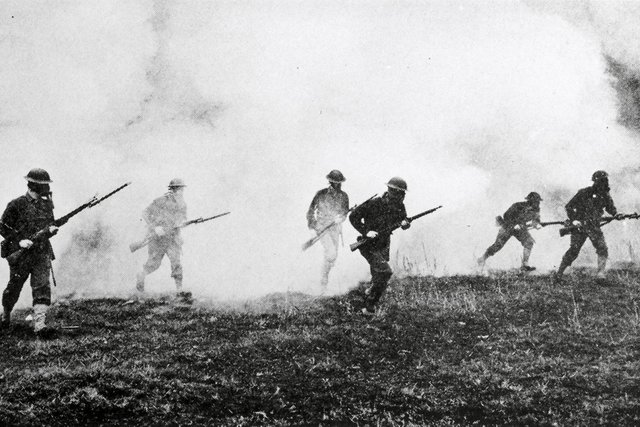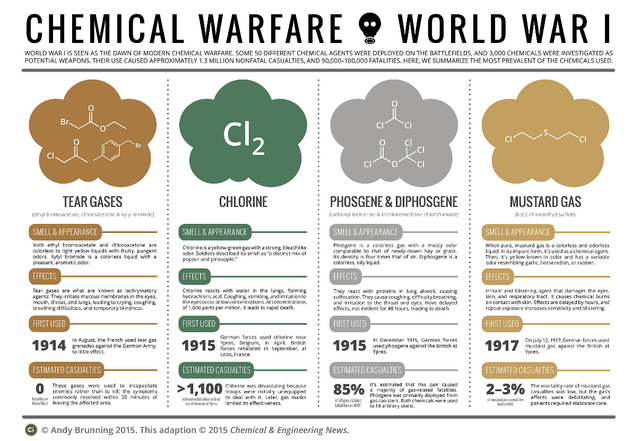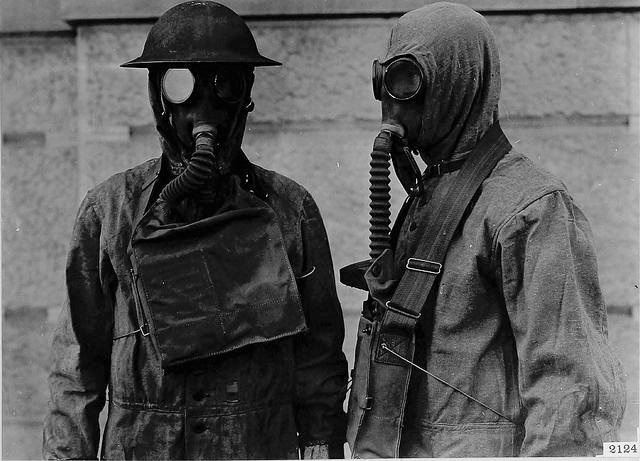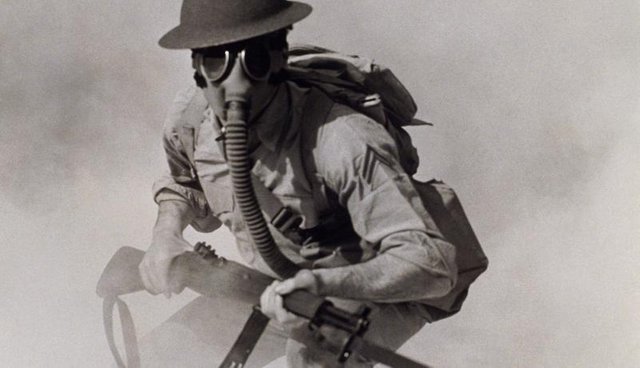Chemical Weapons of The Great War

World War 1 was a unique time in our history. It was the first time a war affected the majority of the world, and also brought about a change in how wars were fought. One aspect of this change was the use of chemical compounds.
Using chemical agents began in 1915 when a German scientist proposed using Chlorine gas on the Allies stationed in the trenches of Ypres, Belgium. This first use of chemicals was originally a test in which much of the German high command doubted its effectiveness, but after this poisonous weapon killed over 1,000 allied soldiers within hours of its release, the support was overwhelming to develop and deploy this new method of attack.
The poisonous arms race
After the first use of chlorine gas in Belgium, both sides began stockpiling the chemical while designing even more deadly compounds to be used as weapons. It is said that by the end of the War in 1918, some 3,000 different compounds were created as a weapon.

Common Chemicals and Dates of Usage:
Tear Gas- 1914
Is comprised of Ethyl Bromoacetate, chloroacetone and xylyl bromide which is a light yellow gas. Tear Gas irritates the eyes, mouth, and throat causing coughing and breathing difficulties while impairing the vision. The first tear gases used in WW1 had minimal effects and as such, became less commonly used.
Chlorine Gas- 1915
Chlorine crystals readily turn to vapor in open air creating massive clouds of chlorine gas. Since it is a heavier compound it will sink to the ground, creating low lying clouds that cover massive areas of land with the toxic gas. The first uses of Chlorine caused massive deaths for the allies in Belgium trenches and became common use in all theaters of the remaining war.
Phosgene & Diphosgene Gas - 1915
Carbonyl dichloride and trichloromethane chloroformate is a colorless gas that also is denser than air, causing it sink and create low lying clouds of toxic gases. These chemicals will react with lung tissue causing suffocation. The first uses of Phosgene came at the end of 1915 and quickly became the most common and most deadly chemical agent. This chemical was used to fill artillery shells and could be shot into the enemies trenches which subsequently caused over 80% of the Chemical related deaths of WW1.
Mustard Gas - 1917
When used a chemical agent, mustard gas is a yellowish color and contains a horrible intense smell. It is a severe irritant that damages the eyes and respiratory tracts while producing chemical burns when in contact with skin. The use of mustard gas came in 1917 and although it didn't kill many people, the effects of the gas wounded many soldiers for long periods of time. This gas was also developed to counteract the Gas mask which was useful in deterring the other chemicals gases being used.

Countering Chemical Warfare
The first uses of gas were very effective because soldiers didn't have any protection and armies were massively caught off- guard. Shortly after, Gas masks were produced and became increasingly more effective while becoming a necessity for a common soldier to have.
Chemical agents in WW1 became less effective in actually killing soldiers because of the gas masks, but were used as more of a psychological factor. Causing breathing problems, and sickness, many soldiers were forced to wear masks at all times in fear of chemicals, and the gas itself caused stagnant clouds of death that would hover in battlefield.

The Great War or WW1 was an interesting time. Many changes happened in the world and in the ways wars were fought changed dramatically. The introduction of the Machine Gun, Tanks, airplanes and Chemical gases caused massive causalities and horrific terror in the battlefield.
100years ago, the world was engulfed in war. The history of it amazing me.
Thank you for reading and up voting. Comments are always welcomed
Follow me @generation.easy
image credit:
1: www.icrc.org